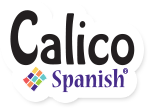“Kids learn Spanish in minutes!”: 4 myths curriculum companies are selling
Kids learn Spanish every day. They learn it in elementary classrooms, in play groups, and in day cares. They learn it with Pepe the brown dog in Stories. But kids learn Spanish in specific ways, under specific conditions, and if those conditions aren’t met, language acquisition simply won’t happen. That’s the science.
Still, myths swirling around the internet range from misleading information to outright lies. There they are, waiting to lure you. What’s the bait? The bait is a promise: we’d all love to see our kids speaking Spanish with little time or effort, right? But let’s be careful to evaluate marketing messages against what linguists know about how children learn language.

Let us deconstruct of few of these myths for you.
– Like Calico Spanish on Facebook –
1. Kids learn Spanish by understanding grammar.
As you look for tools to support the young Spanish learners in your life, you might come across claims like
it’s really important to give students a basic understanding of Spanish grammar concepts
Or a company offering classes might assure you,
Children will learn articles, nouns, and verbs and have the opportunity to use their new knowledge.
The learning system might assure you that color-coding grammatical gender and verb endings is going to be the key to kids learning and using proper grammar in Spanish. Now, using colors to get learners to notice grammatical changes in words is something I do in the classroom – when those learners are in the ninth grade. Young children simply are not ready to analyze the grammar of a language. They internalize it naturally, and that’s the beauty of natural language acquisition. Children can use the grammar correctly; they just can’t explain why. And if they can’t explain why, that means it doesn’t do any good to explain it to them. Honestly, they’ll just think you’re trying to make the content pretty.
Our tip: Look for programs that offer language children will understand and want to pay attention to, like fun stories. Then, trust that when correct grammar goes in, correct grammar (eventually) comes out.
– Follow the blog on Bloglovin –
2. Kids learn Spanish in “just minutes.”
This might be the most common propaganda you’ll see on the internet. Your kids will speak Spanish the first day. X program is lightning-fast.
You don’t need to read a lot of research to know this is a lie. You just need to remember how long it took your children to do this the first time around: how long for the individual words. (“Ball.”) How long to put two words together. (“Ball up!”) How long they gave you chunked phrases because they’d heard the words together and understood them as one word. (“Hold you!”) My son is five years old and today he said “I want she to put it on.” He’s never heard that construction. His brain is working out the grammar. And it’s taking this long to do it. No one thinks this is unusually slow. It’ll take years for your child to show measurable proficiency in their new language. But that’s okay, and it’s worth it.
When companies say this what they usually mean is that you’ll hear something in Spanish from the beginning. That could be true. But that’s not what they say – and it doesn’t mean the kids will be able to order their food in Spanish at that amazing taco truck.
All that to say, find a curriculum with the right process, trust the process, and accept the stages that come as they come.
– Follow Calico Spanish on Twitter –
3. Kids learn Spanish from curriculum that’s won “awards.”
You know those badges and ribbons you see plastered on so many educational product sites? Heads up: business awards are a scam. The curriculum has an award from “Dr. Toy”? You may not even be able to investigate those awards (I can’t) because the site security is out of date. The program has been named “Mom’s Best”? That’s because the program paid to be named “Mom’s Best.” That’s the way most of these awards work: the company pays a fee, and then the award group (maybe) evaluates the program and sends a digital badge to the curriculum company.
We’ve received various emails offering these awards to us. We’re told “submissions will not be evaluated without payment” and also that they “require four non-returnable samples” of the product. They say that “normally the price is $495 to be included” on the list, and we’ll get a “snazzy award seal” for our website, but since we’re a small business, the price can go down to $395. We’re told to nominate ourselves via email, pay the entry fee, and if we’re chosen we’ll get that award seal (these groups like the word “snazzy”).
Our advice? Totally ignore the “awards” a site/product/program has “won.” Look for reviews by real people, and evaluate that way. The opinion from someone who used the program because they needed it and wanted to talk about it is far more trustworthy than that “snazzy badge.”
– Follow us on Instagram too! –
4. Kids learn Spanish by clicking and tapping.
The world is changing. The employment prospects are changing. And ostensibly, education is changing. Do kids need to engage in problem-solving and independent learning. Yes, they do! But their world language program is not the best place to do it.
When a curriculum company promises independent learning, be skeptical. As tempting as it is for families to believe you can set a child in front of a screen, go prepare dinner, and when you get back they’ll be speaking in Spanish, this is a myth! Language has always required personal connections to develop. That’s why we have language- to connect with people!
Though we developed our Stories program to include as much support as a teacher or parent would need if they spoke zero Spanish themselves, we still want to push kids off the screen. We say it in the introduction of our teacher’s guides and we believe it: lifelong language skills come from taking a personal interest in the target language community and becoming a part of it. Make friends, and you’ll see the skills grow and grow- and, of course, your kids will have more friends. Who doesn’t need that?
A few more tips:
For some real advice and research-based tips on raising bilingual children, check out this helpful resource from Mom Loves Best.
Beware of a program emphasizing homework (doing what?) or correct pronunciation. Especially young children distinguish and reproduce language sounds much better than adults of similar aptitude; it’s simply a non-issue.
Look for activities and tasks that get children engaging with comprehensible, accurate language and interacting with it over, and over, and over, in varied contexts. Then you’ll see how kids learn Spanish. As we like to say, you’ll see more smiles, and hear more Spanish.
Introduce a child you love to a lifelong journey of speaking real Spanish to real people. Click the red button to experience it FREE.
Sara-Elizabeth Cottrell is the chief storyteller for Calico Spanish. She’s been working with language learners for 24 years and has three bilingual children. She’s never seen language acquisition happen “lightning-fast,” but she’s seen it be worth the time it takes every single time.






No Comments